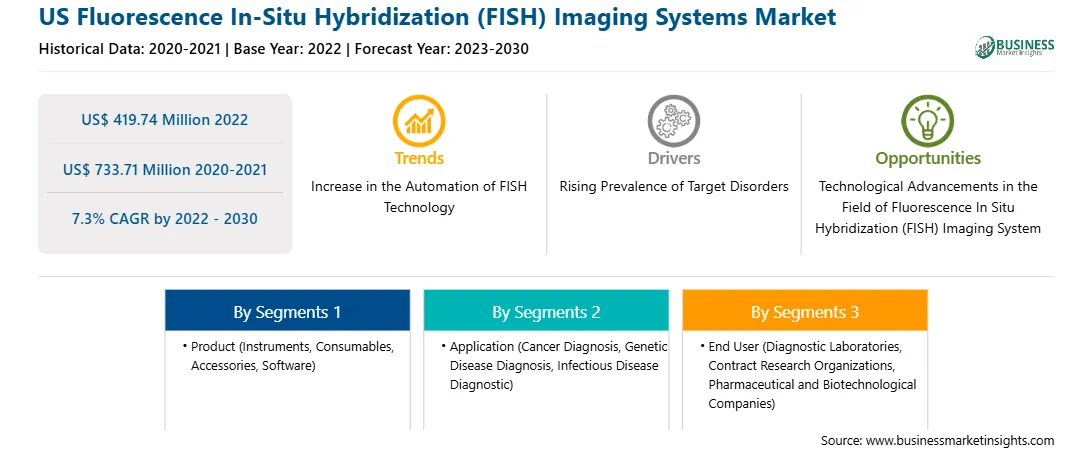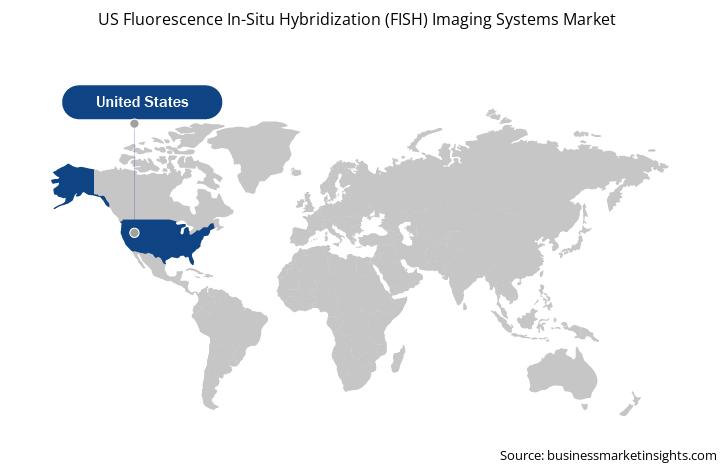The key factors driving the market's growth are rising prevalence of target disorders and the increasing R&D investments in in-vitro diagnostics. However, high cost of fish imaging systems and procedures is hampering the market's growth to a certain extent.
FISH imaging systems are witnessing a remarkable evolution due to the surge in technological advancements, which result in cutting-edge innovations transforming the landscape of genetic research and diagnostics. These advancements include enhanced optics, more sensitive and versatile fluorophores, and sophisticated automation features. Modern FISH imaging systems, integrated with these upgraded features, offer greater sensitivity, improved image resolution, and faster processing times. Moreover, these technological advancements have extended the application scope of FISH imaging from cancer diagnosis to genetic predisposition testing. In July 2021, BioView and Capio Biosciences collaborated to create a platform for collecting circulating tumor cells (CTCs) from whole blood. By integrating their technologies, these companies further worked on improving the CTC liquid biopsy downstream analysis. Similarly, in collaboration, BioView and Capio Biosciences partnered with RUBYnanomed in December 2020 to create a unique imaging solution to accelerate the acceptance and adoption of CTC technology in clinics to enhance cancer detection. Thus, technological advancements in FISH imaging systems create significant opportunities for companies in the fluorescence in-situ hybridization (FISH) imaging systems market.
Computerized tomography (CT) scan, immunohistochemistry (IHC), bone scan, FISH imaging, magnetic resonance imaging (MRI), positron emission tomography (PET) scan, ultrasound, and X-ray are among the tests used to detect cancer. FISH imaging analysis is a less commonly used method in cancer detection because of its relatively higher cost than other methods. In addition to the equipment cost, the expenses associated with reagents, other consumables, and specialized personnel appointments can add to the overall cost of evaluation based on FISH imaging. For instance, the detection of ALK gene non-small cell lung cancer by IHC costs US$ 90.07 in the US for every test, which is less than either independent or parallel testing by FISH and IHC (costing ~US$ 441.85 in the US). Thus, the high cost of procedures and systems limits the growth of the fluorescence in situ hybridization (FISH) imaging systems market.
Based on product, the fluorescence in-situ hybridization (FISH) imaging systems market is segmented into instruments, consumables, accessories, and software. The consumables segment held a larger market share in 2022 and is anticipated to register a higher CAGR. Consumables are the most promising segment of the fluorescence in-situ hybridization (FISH) imaging system market that will contribute to tremendous growth in the coming years. FISH consumables include hybridization buffers, probes, tag detection kits, signal amplification detection kits, and others. The presence of manufacturers such as Abbott, F. Abnova, and Thermo Fisher Scientific bolsters the market for the consumables segment. Additionally, these products are frequently used in various research diagnosis processes, which is expected to propel consumption. Thus, the presence of various market players offering probes & kits and technological advancements by market players are likely to propel the market for the segment in the coming years.
Based on application, the fluorescence in-situ hybridization (FISH) imaging systems market is segmented into cancer diagnosis, genetic disease diagnosis, infectious disease diagnosis, and others. The cancer diagnosis segment held a larger market share in 2022 and is anticipated to register a higher CAGR. FISH technology has tremendously benefited cancer diagnosis. FISH imaging systems can look for gene changes and help detect anomalies. According to Cancer Research UK, FISH testing is used for the diagnosis of several cancers, including breast cancer, lymphoma, lung cancer, prostate cancer, chronic lymphocytic leukemia (CLL), acute lymphoblastic leukemia (ALL), acute myeloid leukemia (AML), chronic myeloid leukemia (CML), myeloma, Ewings sarcoma, and melanoma skin cancer.
Based on end user, the fluorescence in-situ hybridization (FISH) imaging systems market is segmented into diagnostic laboratories, contract research organization, pharmaceutical and biotechnological companies, and others. The diagnostic laboratories segment held a larger market share in 2022 and same segment is anticipated to register a higher CAGR. The diagnostic laboratories are involved in various research projects to develop several technologies and products for fluorescence in-situ hybridization (FISH) imaging processes. Unprecedented developments in research and technologies have created the potential for transformation in the healthcare and life sciences sectors. The clinical applications of fluorescence in-situ hybridization (FISH) imaging systems are vast and offer opportunities to enhance diagnosis and treatment capabilities for chronic disease. They offer huge potential in gene discovery and diagnosis of rare genetic disorders. The technologies are increasingly used to analyze rare and common genetic factors influencing the development of common diseases, such as cancer, high blood pressure, diabetes, and renal diseases.
The growing demand for advanced diagnostic tools in molecular genetics and cytogenetics and the rising prevalence of genetic disorders and cancer fuel the adoption of fluorescence in-situ hybridization (FISH) imaging systems. As per data published by the American Cancer Society in 2022, there are around 1.9 million new cancer cases diagnosed in the US and 609,360 cancer deaths. These systems offer high-resolution imaging of genetic material, enabling researchers and clinicians to detect chromosomal abnormalities and gene mutations with greater accuracy. Furthermore, the increasing focus on personalized medicine and targeted therapies has led to an upsurge in research activities involving genetic analysis, bolstering the demand for FISH imaging systems. The ability of these systems to provide detailed spatial information on gene sequences directly within cells has proven invaluable in both research and clinical applications. The popularity of technological advancements in FISH imaging systems, such as improved automation, higher throughput, and enhanced image analysis software, has also increased in recent years. As a result, laboratories and medical institutions are better equipped to handle larger volumes of samples and generate precise results efficiently. Thus, the abovementioned factors will fuel the fluorescence in-situ hybridization (FISH) imaging systems market growth in the US.
A few of the major primary and secondary sources referred to while preparing the report on the fluorescence in-situ hybridization (FISH) imaging systems market are the World Bank Data, National Health Service (NHS), FDA (Food and Drug Administration), EMA (European Medicines Agency), and WHO (World Health Organization).
Strategic insights for the US Fluorescence In-Situ Hybridization (FISH) Imaging Systems provides data-driven analysis of the industry landscape, including current trends, key players, and regional nuances. These insights offer actionable recommendations, enabling readers to differentiate themselves from competitors by identifying untapped segments or developing unique value propositions. Leveraging data analytics, these insights help industry players anticipate the market shifts, whether investors, manufacturers, or other stakeholders. A future-oriented perspective is essential, helping stakeholders anticipate market shifts and position themselves for long-term success in this dynamic region. Ultimately, effective strategic insights empower readers to make informed decisions that drive profitability and achieve their business objectives within the market.

| Report Attribute | Details |
|---|---|
| Market size in 2022 | US$ 419.74 Million |
| Market Size by 2030 | US$ 733.71 Million |
| Global CAGR (2022 - 2030) | 7.3% |
| Historical Data | 2020-2021 |
| Forecast period | 2023-2030 |
| Segments Covered |
By Product
|
| Regions and Countries Covered | United States
|
| Market leaders and key company profiles |
The geographic scope of the US Fluorescence In-Situ Hybridization (FISH) Imaging Systems refers to the specific areas in which a business operates and competes. Understanding local distinctions, such as diverse consumer preferences (e.g., demand for specific plug types or battery backup durations), varying economic conditions, and regulatory environments, is crucial for tailoring strategies to specific markets. Businesses can expand their reach by identifying underserved areas or adapting their offerings to meet local demands. A clear market focus allows for more effective resource allocation, targeted marketing campaigns, and better positioning against local competitors, ultimately driving growth in those targeted areas.

The US Fluorescence In-Situ Hybridization (FISH) Imaging Systems Market is valued at US$ 419.74 Million in 2022, it is projected to reach US$ 733.71 Million by 2030.
As per our report US Fluorescence In-Situ Hybridization (FISH) Imaging Systems Market, the market size is valued at US$ 419.74 Million in 2022, projecting it to reach US$ 733.71 Million by 2030. This translates to a CAGR of approximately 7.3% during the forecast period.
The US Fluorescence In-Situ Hybridization (FISH) Imaging Systems Market report typically cover these key segments-
The historic period, base year, and forecast period can vary slightly depending on the specific market research report. However, for the US Fluorescence In-Situ Hybridization (FISH) Imaging Systems Market report:
The US Fluorescence In-Situ Hybridization (FISH) Imaging Systems Market is populated by several key players, each contributing to its growth and innovation. Some of the major players include:
The US Fluorescence In-Situ Hybridization (FISH) Imaging Systems Market report is valuable for diverse stakeholders, including:
Essentially, anyone involved in or considering involvement in the US Fluorescence In-Situ Hybridization (FISH) Imaging Systems Market value chain can benefit from the information contained in a comprehensive market report.